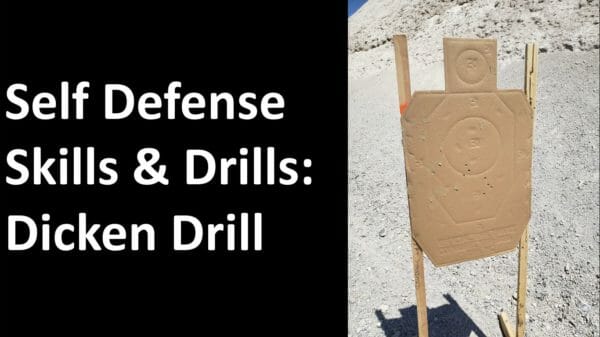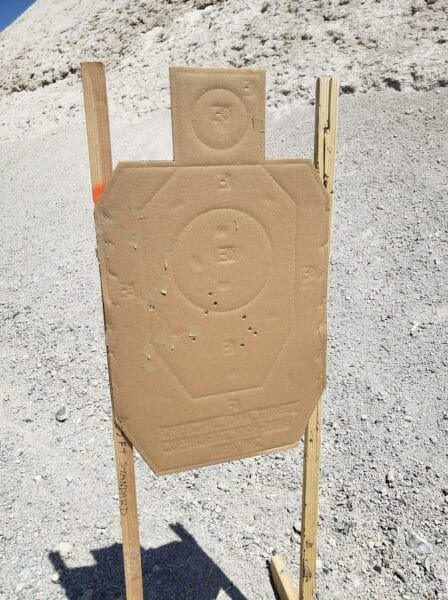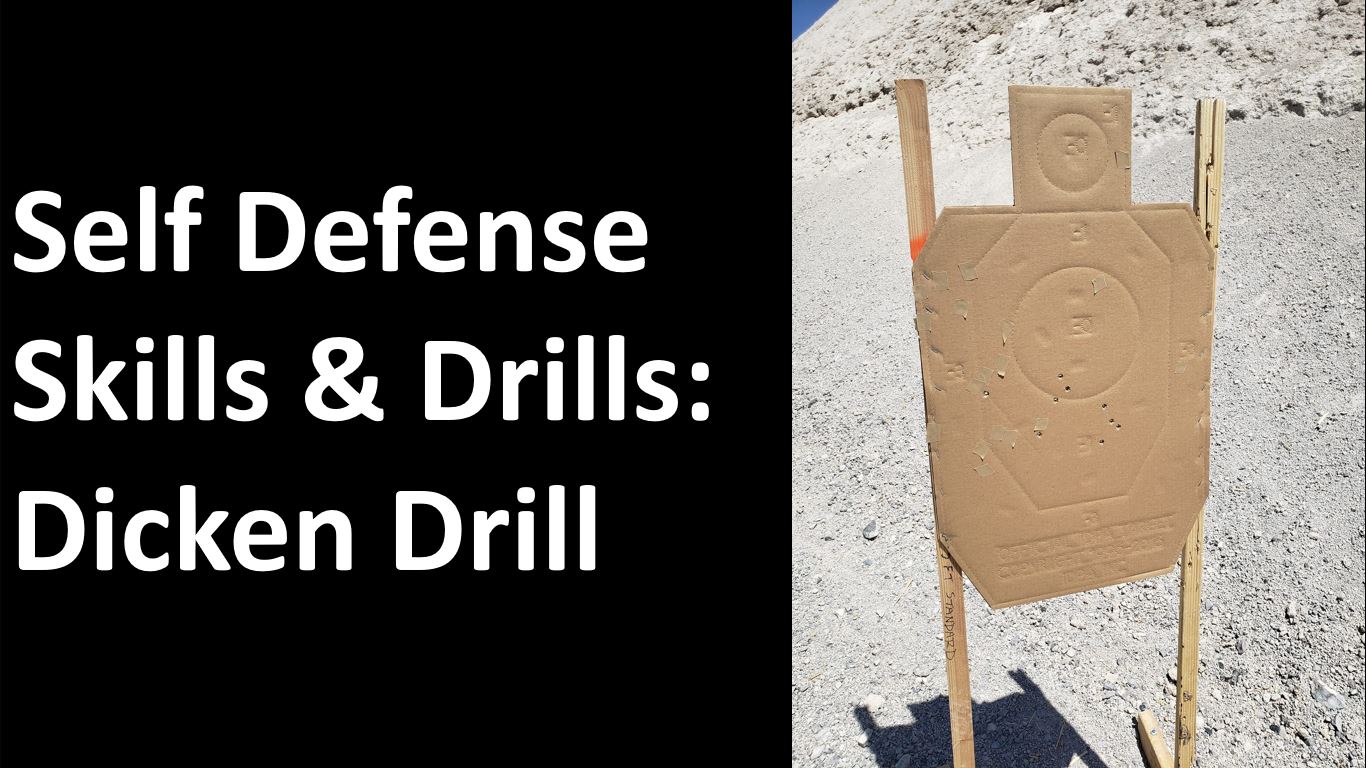
By now, I’m sure we’ve all heard the story of Eli Dicken, who singlehandedly stopped an active shooter at the Greenwood Mall in Indiana. You’ve probably also seen some viral posts floating around about the so-called “Dicken Drill,” giving folks an opportunity to recreate what is currently understood as the events of that day.
Initially, I was planning on holding off on shooting the drill myself, waiting for more data to come forth about the Greenwood Mall shooting. However, I recently had the chance to shoot the drill, and have some opinions of my own to counter some of the discussions floating around online. With that being said, let’s check out the Dicken Drill.
Setting Up the Drill
The equipment requirements for firing the Dicken Drill are very simple. You’ll need a single silhouette target, ideally an IDPA torso, IALEFI-Q, or something similar. Place this target at 40 yards from your firing position. On your person, you’ll need a pistol, which will be worn concealed. Only one magazine is needed, loaded to 10 rounds total in the gun; reduced capacity guns will need a reload to achieve 10 rounds. Some way to measure time is also necessary to record your par time.
Scoring the Dicken Drill
There are two major ways of scoring the Dicken Drill. Both maintain the same distance, par time, rounds fired, and start from concealment but differ in the scoring method. Additionally, both are supposed to be shot cold, with no warm-up.
The first is what we’ve likely all seen through a viral meme. This is based on USPSA Hit Factor scoring and uses a USPSA torso to achieve its related score. Shooters use Hit Factor scoring, with Minor Power Factor, requiring 1.25 HF to pass the drill. A supported position is allowed, similar to the support that Eli allegedly used in his shooting, but that adds 3 seconds to your time calculation. For those who don’t understand Hit Factor, I suggest you check out THIS article for more information.

When I shot the Dicken Drill at an IDPA match, we used a different method of scoring since Hit Factor doesn’t exist in IDPA. Instead, we simply had a hard par time of 15 seconds. Time was added for dropped shots in accordance with IDPA scoring zones; adding 1, 3, or 5 seconds for hits in the -1, -3, or completely off the paper. No barricade was offered for support, making it completely offhand shooting. Additionally, only the 8 best hits were counted, matching the hits that Eli made during the Greenwood Mall incident.
This method is my preference for simplicity. The IDPA torso and similar targets also provide a more realistic vital area for targeting.
Firing the Drill
There is only one stage with the Dicken Drill. Start with your hands relaxed at your side, cover garment concealing your pistol. On the beep, draw and fire ten rounds at the target within the 15 second par time. Once finished, retrieve your target and check your hits.
My Results on the Dicken Drill
I recently attended my first IDPA match in my new home. One of the four stages shot during the match was our version of the Dicken Drill. The biggest difference here was using IDPA scoring, but the distances, rounds fired, and par time remain the same. For this match I was using my Gen4 Glock 19 with a Steiner MPS mounted on a Forward Controls Design plate. The gun was carried concealed, AIWB, in a Tenicor Velo4, and loaded with Blazer Brass 115gr FMJ.

From 40 yards, I fired all ten rounds in 10.64 seconds, landing all but one on the IDPA torso. Dropping seven rounds into the -1 scoring zone netted me a final time of 16.64 seconds. This performance landed me as the 10th best shooter on the stage out of 43 participants. This was roughly an average day for me, with hits a little lower than I’d like but not unreasonable. For reference, the top shooter on the stage made a raw time of 8.34, with a final score of 10.34, dropping two rounds into the -1 zone of the target.
Final Thoughts on the Dicken Drill
The Dicken Drill is a solid mix of fun and realism. Most shooters don’t have the opportunity nor the motivation to shoot at distances in excess of even 25 yards. It’s a great skill check to see if you can even stay on target at extended distances, let alone get effective fight-stopping hits. Additionally, Eli has done an excellent job at showing self-defense can happen outside of bad breath ranges.
It isn’t tactical training, nor is it realistic in the sense of a sanitized range versus a mixed threat environment you’d encounter in the real world, but neither are most other drills. Anything that gets shooters out there to improve their skills is a good thing. Have you tried your hand at the Dicken Drill? Let us know how you stack up in the comments.
About Dan Reedy
Dan is an Air Force veteran, avid shooter, and dog dad. With a passion for teaching, he holds instructor certifications from Rangemaster, Agile Training & Consulting, and the NRA. He has trained with Darryl Bolke, Mike Pannone, Craig Douglas, among several other instructors, amassing over 400 hours of professional instruction thus far. In his spare time you’ll find him teaching handgun, shotgun, and less lethal classes.
Dan’s work has been published by Primer Peak, and The Kommando Blog, and he has been featured as a guest on Primary & Secondary.



I thought Dicken started at 40 yards and then closed the distance still firing from what I read. Any clarification on this?
When the dust is settled and we get to see the actual video and the crime scene measurements then we well know exactly what happen.
I have been shooting and instructing longer range handgun shooting for decades.
It is nice to see the utility of it coming out.
Paul Harrell made a great point in one of his videos. We do not know whether Eli Dicken wants his name associated with this drill in any way. He may well want to put this experience behind him as quickly and thoroughly as possible. Unless and until he speaks, we should assume that he would prefer to not be associated with such drills – just calling it the “Greenwood drill” or “Greenwood Mall drill.”
Practice, know your gun, practice more.
I remember a Shooting USA episode with a guy hitting a balloon at a hundred yards with a snub nose 38 special. Why get any closer than needed?
I have to wonder how much movement there was from the bad guy and Dicken. Was Dicken moving forward? Did the bad guy move away or toward cover? Movement makes the shots that much more difficult.